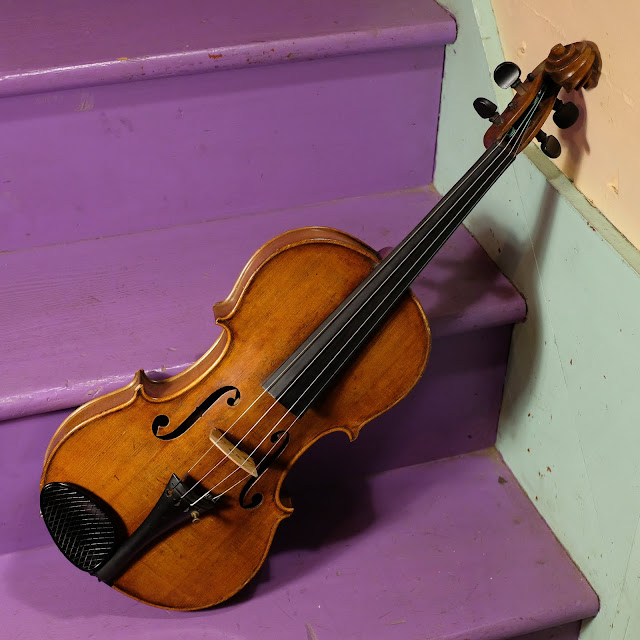1920s American-made Short Scale Viola
I took this beaut in trade for work and so I figured I should get it ready to roll. I'm not exactly sure where it was made as it has no label, but the neck appears to be made from black walnut, so I gather that it was probably made in the States. I don't know any other region where walnut would've been first choice for necks because I've only ever seen it used once in a while on American instruments from this age.
It's well-made and clean in its details and has a lightweight cut overall with a medium arch to both the top and back. It's only a little larger than a 4/4 violin with a slightly-longer body and slightly-deeper sides. It has a 13 5/8" scale length which means that, in a pinch, it makes a good "oversized fiddle." I've strung it up with violin strings and tuned it FCGD low to high -- a full step lower than violin pitch. The strings could take being tuned up to GDAE, however. They're perlon-core John Pearse Mezzos and basically react and sound like Dominants.
While this could certainly be used as a proper viola, I think it might prove more useful to a fiddler looking for a slightly-larger instrument and the warm, sweet, full, and rounded tone this has. I find that I like the extra bit of length between notes on the fingerboard, for sure. It's much more natural for my hands than the usual 13" scale of a 4/4 fiddle.
Work included: seam repairs, setting the soundpost, mild cleaning, and a setup. It has 1/8" action height at the end of the fingerboard and a quick feel. The board itself is straight and the neck has a comfortable, slim-to-medium C shape to it.
Scale length: 13 5/8"
Nut width: 15/16"
String spacing at nut: 3/4"
String spacing at saddle: 1 5/8"
Nut width: 15/16"
String spacing at nut: 3/4"
String spacing at saddle: 1 5/8"
Body length: 14 7/8"
Lower bout width: 8 1/2"
Upper bout width: 7"
Lower bout width: 8 1/2"
Upper bout width: 7"
Ribs depth: 1 1/2" +
Top wood: solid spruce
Back/sides: solid maple
Neck wood: black walnut
Fingerboard: ebony
Back/sides: solid maple
Neck wood: black walnut
Fingerboard: ebony
Neck shape: slim-to-medium C rear, bevel for bass string
Bridge: period maple, recut, nice quality
Nut: ebony
Condition notes: it's all-original as far as I can tell, save new tailgut, new strings, and perhaps one of the pegs at the headstock. There are two tiny, very tight, repaired hairline cracks -- one under the chinrest about 1" long and one at the side near the heel the same length. They pose no issues. There are the usual minor scratches, scuffs, and dings from use -- but it's overall a very handsome instrument.
It comes with: a nice vintage hard case (Lifton branding).
The maple isn't very figured but check out those rays, huh? Nice stuff.



















Comments